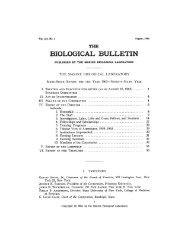View/Open - HPS Repository
View/Open - HPS Repository
View/Open - HPS Repository
Create successful ePaper yourself
Turn your PDF publications into a flip-book with our unique Google optimized e-Paper software.
In the first part on plasmatic maturation of the egg, he comes to the conclusion<br />
that there is a causal sequence in plasmatic and nuclear maturation. The<br />
spatial distribution of the plasmatic inclusions is based upon the structure of the<br />
"groundplasm". The inclusions have no organ-genetic significance, but can be<br />
necessary for the normal development of certain organ-systems.<br />
From the second part on determination the author concludes that the principle<br />
of progressive determination does not hold for the cleavage period up<br />
to the blastula stage. Determination is not based upon a special segregation of<br />
organ-forming substances, but must depend upon the structure of the groundplasm<br />
which is also the seat of the power of regulation. The local properties of<br />
the ground plasm determine the differentiation of the enclosed nucleus. The role<br />
of cleavage is thought to be the provision of totipotent nuclei in the various<br />
plasm areas and the spatial segregation of these groundplasm areas.<br />
The third part deals with the various gradient theories and the phenomena<br />
of induction and organization. The author finds many points of correspondence<br />
with the conclusions made in Child's book "Patterns and problems of<br />
development", 1941. He however denies that gradients are based upon differences<br />
in metabolic activity, but states that the latter are merely an expres-<br />
sion of processes of differentiation.<br />
In the last part the relation between the genes and the plasm gradients is<br />
discussed. The author concludes that gradients actually exist and play a decisive<br />
role in the process of differentiation. Their nature and origin remain however<br />
questionable. He denies the role of substances as well as metabolic gradients,<br />
but concludes that differentiation must be based upon gradients in the<br />
structure of the groundplasm. Direct evidence is however still restricted.<br />
So far the author's considerations are very well argued. His further suggestion<br />
that chromosomes also possess gradients, and that genes of a certain<br />
chromosome gradient traject can only react with a certain plasm gradient<br />
traject is still too speculative, and reduces to some extent the great value of<br />
this important work.<br />
This very interesting theoretical work deals with a large number of fundamental<br />
problems, in which, we hope, all embryologists will be interested, so<br />
that this work will contribute to a sharper theoretical planning of the experimental<br />
analysis and consideration of the results obtained, which is a highly<br />
desirable aspect. The fact that the work has been written in war time, and<br />
had to wait so long before publication could be prepared, has led unfortunately<br />
to the fact that several recent advances in the experimental analysis have not<br />
been incorporated and synthesized in this work.<br />
P. D. NIEUWKOOP<br />
"MITOSE,<br />
die Bewegung der Chromosomen bei der Zellteilung"<br />
1954<br />
by Fr. Schrader Verlag Franz Deuticke, Wien<br />
150 pp. with 19 figs Price: ?<br />
Since 1944 so much progress has been made in the analysis of the process<br />
of mitosis, changing our opinions, that a revision of the first edition has become<br />
highly desirable. Particularly the use of the phase contrast microscope and the<br />
polarisation microscope, and the development of new techniques for the electron<br />
197
















